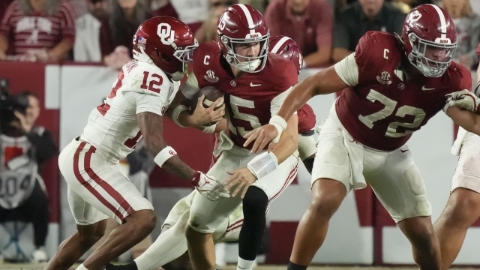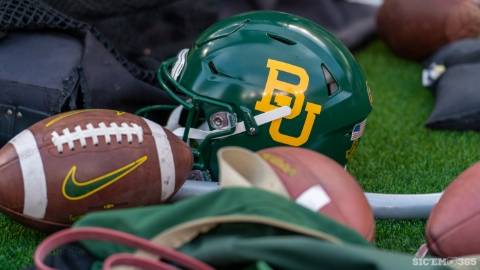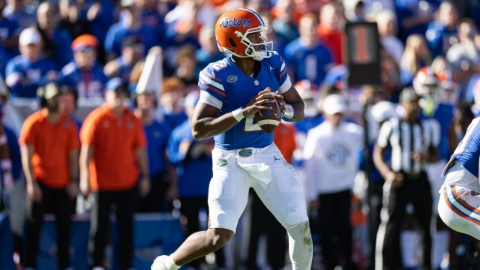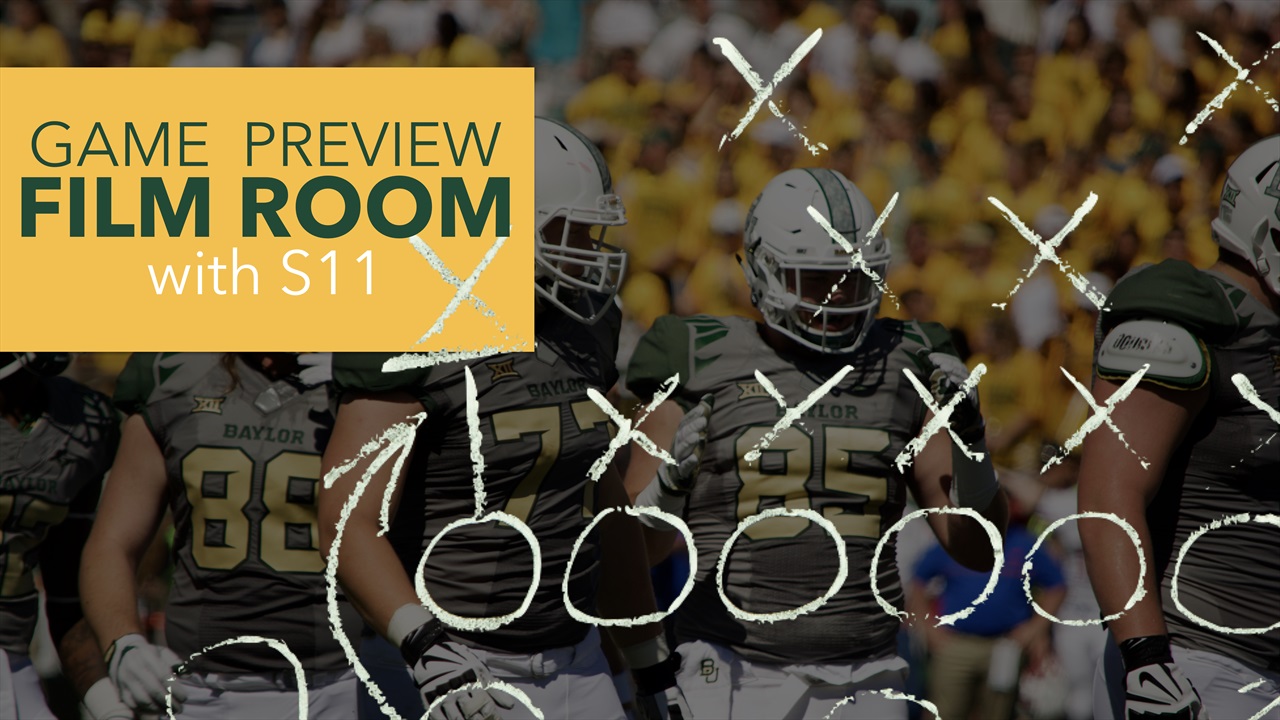
The Horned Frog's defense and Patterson's famous 4-2-5 scheme has given offenses headaches for almost 20 years now. TCU's defensive scheme has been the backbone of their success under Patterson.
They divide their playcalls into the following three attack groups.
The safeties line up based on the passing strength. The weak safety is away from the strength and their strong safety is towards the strength.
In this system their strong safety is more of a nickel player. It is a comparable position to Baylor's BEAR position where Travon Blanchard plays.
The free safety is typically the deepest of the safeties and most coverage oriented of the three.
The two linebackers are stacked behind the line with the SLB lining up towards the run strength.
The defensive ends are outside the offensive tackles, the nose tackle is in a one technique (or a 2i), and the defensive tackle is outside the guard in a three technique.
TCU's basic goal is for their front six to attack, slant, and stunt their way into clogging up the A, B, and C gaps. This optimally would force the ball outside where their outside safeties would force the ball carrier back into traffic.
This scheme places a lot of pressure on the defensive backs to hold up in single coverage more often than some other schemes. Several of Baylor's bigger pass plays in the recent years of the series are the result of threatening TCU with the run and leaving single coverage for the passing game to defeat.
Oklahoma was able to use motion to isolate their best receiver on TCU's nickel safety for a deep touchdown.
TCU gives up a high percentage of completions but that may simply be a product of playing some very capable quarterbacks and offenses.
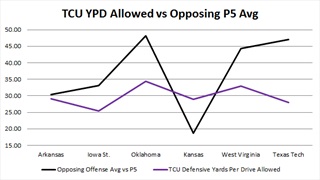 SicEm365
SicEm365
TCU does a good job in the red zone giving up 70% of available points.
In terms of yards per drive compared to expectations the Frogs had their best outing against Texas Tech (59% of expected) and worst against Kansas. (154% of expected)
At linebacker TCU returns everyone from last year. Invariably they will use two out of #32 Travin Howard (6-1, 210, JR), #19 Montrel Wilson (6-3, 210, SO), #42 Ty Summers (6-2, 235, SO), and #35 Sammy Douglas (6-3, 215, JR) at their two linebacker spots. Howard and Wilson are converted safeties who move extremely well for the position and started most of last season. Douglas faced injuries last season and Summers had a standout performance in the rain against Baylor last fall.
The Frogs start #30 Denzel Johnson (6-2, 210, SR) at strong safety, converted corner #18 Nick Orr (5-10, 187, JR) at weak safety, and #2 Niko Small (5-10, 180, SO) at free safety. The Frogs have struggled at corner but feature 2014 starter #11 Ranthony Texada (5-10, 170, JR) at one spot. They have started #28 Tony James (5-10, 162, SO), #12 Jeff Gladney (6-1, 175, RS FR), and #24 Julius Lewis (5-10, 170, SO) at the other corner spot. Receiver #20 Deante Gray (5-10, 183, SR) and safety #18 Nick Orr (5-10, 187, JR) have also been tried there.
Baylor 37, TCU 27
Follow @Baylor_S11 on Twitter!
SCHEME
The 4-2-5 is named for it's use of four linemen, two linebackers, and five defensive backs. It's not soft against the run though. It's a defense that uses one-gap principles to outnumber the run and rely on their three safeties and two corners to hold up in difficult coverages. It's the same base scheme that the Bears faced against Rice earlier this year but the Horned Frogs have significantly more talent.They divide their playcalls into the following three attack groups.
- The Free Safety, Corner, Strong Safety, and one Linebacker operating on one call made by the Free Safety.
- The Weak Safety , remaining Linebacker, and other Corner operate on the Weak Safety's call.
- The Linebackers and Line operate on a front call.
The safeties line up based on the passing strength. The weak safety is away from the strength and their strong safety is towards the strength.
In this system their strong safety is more of a nickel player. It is a comparable position to Baylor's BEAR position where Travon Blanchard plays.
The free safety is typically the deepest of the safeties and most coverage oriented of the three.
The two linebackers are stacked behind the line with the SLB lining up towards the run strength.
The defensive ends are outside the offensive tackles, the nose tackle is in a one technique (or a 2i), and the defensive tackle is outside the guard in a three technique.
TCU's basic goal is for their front six to attack, slant, and stunt their way into clogging up the A, B, and C gaps. This optimally would force the ball outside where their outside safeties would force the ball carrier back into traffic.
This scheme places a lot of pressure on the defensive backs to hold up in single coverage more often than some other schemes. Several of Baylor's bigger pass plays in the recent years of the series are the result of threatening TCU with the run and leaving single coverage for the passing game to defeat.
Oklahoma was able to use motion to isolate their best receiver on TCU's nickel safety for a deep touchdown.
STATISTICS
TCU's defense has been quietly strong for the last few games. They have held power conference teams to roughly 88% of what they typically generate per-drive, a number that falls to an outstanding 75.5% if you ignore the outlier Kansas game. The Frogs are disruptive with over 3.5% more sacks than their opponent gives up against other power teams. The Frogs have been reasonably strong against the run with their average of 4.37 per carry being skewed by a few long runs. I would guess their median rushing yard per carry is much lower.TCU gives up a high percentage of completions but that may simply be a product of playing some very capable quarterbacks and offenses.
 SicEm365
SicEm365
TCU does a good job in the red zone giving up 70% of available points.
In terms of yards per drive compared to expectations the Frogs had their best outing against Texas Tech (59% of expected) and worst against Kansas. (154% of expected)
PERSONNEL
TCU's starter at nose tackle is #54 Joseph Broadnax Jr. (6-1, 300, SO) who is an athletic and physical player. Their starter at the quicker defensive tackle position is #95 Aaron Curry (6-2, 270, SR) who is undersized but very athletic. Their rotation at defensive end returns #40 James McFarland (6-2, 250, SR) and #94 Josh Carraway (6-4, 250, SR) who have been primary contributors at the position ever since 2013. Young prospect #47 Tipa Galeai (6-5, 235, SO) and relentless pass rusher #9 Mat Boesen (6-4, 235, JR) round out the position. Boesen is a JC transfer who started his career at Boise State. All four of these guys fit the smaller and quicker mold of TCU's defensive ends who can be dynamic pass rushers.At linebacker TCU returns everyone from last year. Invariably they will use two out of #32 Travin Howard (6-1, 210, JR), #19 Montrel Wilson (6-3, 210, SO), #42 Ty Summers (6-2, 235, SO), and #35 Sammy Douglas (6-3, 215, JR) at their two linebacker spots. Howard and Wilson are converted safeties who move extremely well for the position and started most of last season. Douglas faced injuries last season and Summers had a standout performance in the rain against Baylor last fall.
The Frogs start #30 Denzel Johnson (6-2, 210, SR) at strong safety, converted corner #18 Nick Orr (5-10, 187, JR) at weak safety, and #2 Niko Small (5-10, 180, SO) at free safety. The Frogs have struggled at corner but feature 2014 starter #11 Ranthony Texada (5-10, 170, JR) at one spot. They have started #28 Tony James (5-10, 162, SO), #12 Jeff Gladney (6-1, 175, RS FR), and #24 Julius Lewis (5-10, 170, SO) at the other corner spot. Receiver #20 Deante Gray (5-10, 183, SR) and safety #18 Nick Orr (5-10, 187, JR) have also been tried there.
SPECIAL TEAMS
Kicker #27 Brandon Hatfield (6-3, 230, JR) has been mostly solid but is coming off of a horrible game in which he missed three kicks inside of 39 yards. On the season he is 7 of 11. TCU's kickoff return game is fairly strong and their coverage units are decent. Punter #29 Adam Nunez (6-1, 180, RS FR) averages 41 per kick and converted a fake punt this season.FINAL QUESTIONS
What did TCU defense do to slow down Tech offense so well?
Tech was clearly rattled by TCU's surprising switch to a three man front. The Frogs replaced a defensive tackle with another outside safety to become more versatile in coverage and make Patrick Mahomes make plays in tighter throwing windows. This limited his quick strike ability and forced Tech to be patient and a reshuffled Red Raider line to pass protect. The result? 27 yards per drive, four sacks, miniscule 4.14 per pass play, and only 17 points in regulation. Below you get a look at how TCU picked off Mahomes on their first drive. The addition of another strong safety/nickel player on the weakside allowed their usual WS to go well outside his usual role and bracket the strongside slot receiver and come away with the ball.Why wouldn't a team run on this? If the defense adds somebody deep shouldn't the run be open?
By playing their new safety very far away from the line, TCU gave Tech a favorable front to run against. The Red Raiders showed a lack of consistency blocking for their tailbacks on top of miscues by Mahomes and the running backs as well. Below is an example, this run could have gone for much more. Not all of it was the line, but Tech was only able to average 3.4 per carry against TCU who showed this look well over half the time.Will the Tech game defensive adjustments work against Baylor's offense?
I don't think it will. Baylor is a much more consistent running team than Tech and if TCU wants to repeat Iowa State's defensive issues against Baylor they can try this as an every down defense. I don't see TCU holding up with an outnumbered front against Baylor, especially with Seth Russell as an athletic quarterback.beIf Mahomes can run like that on the Frogs, Seth surely will have a big day, right?
It entirely depends on how they are planning to defend him. If they don't have any spy on I can easily see Seth running for sizeable gains.How much would Baylor's play calling change if the Bears are forced to go with true freshman Zach Smith? More deep balls?
Baylor's offense would primarly change to whatever he is comfortable with. From a pure athletic standpoint you would emphasize the designed quarterback runs less. Smith has upside but the use of RPO's, complex plays, and other tactics would entirely depend on what he can handle right now.The Baylor defensive line started slowly in Austin last week and in Ames. Does TCU have the running game to exploit it?
I don't think TCU is by any stretch a dominant offense but they have run it reasonably well on Arkansas, West Virginia, SMU, and Iowa State. Baylor can stop this unit but they have the baseline ability to run it much better than Oklahoma State or Kansas can.How would you attack this defense?
Ultimately it depends on how they are scheming against you but a healthy diet of runs and RPO's until you get the single coverage you want to beat would be a good starting point. Involving Seth as a runner can help as well but I don't see Patterson providing as friendly of a run front as Baylor saw last week.PREDICTION
Both teams have played better than their current season's reputation on defense. Both have some inconsistency at parts of the offense. Baylor has the more physical offense and that is the difference against a Frog team that will be a challenge to defeat in Waco.Baylor 37, TCU 27
Follow @Baylor_S11 on Twitter!
Never miss the latest news from SicEm365!
Join our free email list

